Biochar and Mulch: Hydrologic, Erosive, and Phytotoxic Responses Across Different Application Strategies and Agricultural Soils
Abstract
:1. Introduction
2. Materials and Methods
2.1. Plot Preparation
2.2. Simulated Rainfall
2.3. Germination Tests
2.4. Biochar, Mulch Materials, and Soils
2.5. Statistical Methods
3. Results
3.1. Overall Hydrological and Erosive Response
3.2. Hydrological and Erosive Short Response
3.3. Leachate Phytotoxicity
4. Discussion
4.1. Mulch and Biochar Effects on Soil Hydrology
4.2. Mulch and Biochar Effects on Soil Erosion
4.3. Mulch and Biochar Effects on Soil Phytotoxicity
5. Conclusions
Supplementary Materials
Author Contributions
Funding
Data Availability Statement
Acknowledgments
Conflicts of Interest
Abbreviations
| EC | Electrical conductivity |
| PAHs | Polycyclic aromatic hydrocarbons |
| WHC | Water-holding capacity |
| GC/MS | Gas chromatography-mass spectrometry |
| US EPA | United States Environmental Protection Agency |
References
- Gomez, J.A.; Llewellyn, C.; Basch, G.; Sutton, P.B.; Dyson, J.S.; Jones, C.A. The effects of cover crops and conventional tillage on soil and runoff loss in vineyards and olive groves in several Mediterranean countries. Soil Use Manag. 2011, 27, 502–514. [Google Scholar] [CrossRef]
- Blanco-Canqui, H.; Lal, R. Crop residue removal impacts on soil productivity and environmental quality. Crit. Rev. Plant Sci. 2009, 28, 139–163. [Google Scholar] [CrossRef]
- Ferreira, C.S.; Seifollahi-Aghmiuni, S.; Destouni, G.; Ghajarnia, N.; Kalantari, Z. Soil degradation in the European Mediterranean region: Processes, status and consequences. Sci. Total Environ. 2022, 805, 150106. [Google Scholar] [CrossRef] [PubMed]
- García-Ruiz, J.M. The effects of land uses on soil erosion in Spain: A review. Catena 2010, 81, 1–11. [Google Scholar] [CrossRef]
- Soane, B.D.; Ball, B.C.; Arvidsson, J.; Basch, G.; Moreno, F.; Roger-Estrade, J. No-till in northern, western and south-western Europe: A review of problems and opportunities for crop production and the environment. Soil Tillage Res. 2012, 118, 66–87. [Google Scholar] [CrossRef]
- Silveira, A.; Muñoz-Rojas, J.; Pinto-Correia, T.; Guimarães, M.H.; Ferrão, J.; Schmidt, L. The sustainability of agricultural intensification in the early 21st century: Insights from the olive oil production in Alentejo (Southern Portugal). In Changing Societies: Legacies and Challenges; Delicado, A., Domingos, N., Sousa, L., Eds.; Science Press Social: Lisbon, Portugal, 2018; Volume 3, pp. 247–275. [Google Scholar] [CrossRef]
- Guerrero-Casado, J.; Carpio, A.J.; Tortosa, F.S.; Villanueva, A.J. Environmental challenges of intensive woody crops: The case of super high-density olive groves. Sci. Total Environ. 2021, 798, 149212. [Google Scholar] [CrossRef] [PubMed]
- Rodríguez Sousa, A.A.; Muñoz Rojas, J.; Brígido, C.; Prats, S.A. Impacts of agricultural intensifcation on soil erosion and sustainability of olive groves in Alentejo (Portugal). Landsc. Ecol. 2023, 38, 3479–3498. [Google Scholar] [CrossRef]
- Abrantes, J.R.; Prats, S.A.; Keizer, J.J.; Lima, J.L. Effectiveness of the application of rice straw mulching strips in reducing runoff and soil loss: Laboratory soil flume experiments under simulated rainfall. Soil Tillage Res. 2018, 180, 238–249. [Google Scholar] [CrossRef]
- Gholami, L.; Sadeghi, S.H.; Homaee, M. Straw mulching effect on splash erosion, runoff, and sediment yield from eroded plots. Soil Sci. Soc. Am. J. 2013, 77, 268–278. [Google Scholar] [CrossRef]
- Prats, S.A.; MacDonald, L.H.; Monteiro, M.S.V.; Ferreira, A.J.D.; Coelho, C.O.A.; Keizer, J.J. Effectiveness of forest residue mulching in reducing post-fire runoff and erosion in a pine and a eucalypt plantation in north-central Portugal. Geoderma 2012, 191, 115–124. [Google Scholar] [CrossRef]
- Prats, S.A.; Abrantes, J.R.; Crema, I.P.; Keizer, J.J.; de Lima, J.L. Runoff and soil erosion mitigation with sieved forest residue mulch strips under controlled laboratory conditions. For. Ecol. Manag. 2017, 396, 102–112. [Google Scholar] [CrossRef]
- Shen, H.; Li, H.; Liu, H.; Wu, J.; Li, C.; Liang, Y. Effects of Furrow Corn Straw Mulch on Soil Erosion and Organic Carbon Loss in Sloping Farmland in the Black Soil Region. Agronomy 2025, 15, 66. [Google Scholar] [CrossRef]
- Gholamahmadi, B.; Jeffery, S.; Gonzalez-Pelayo, O.; Prats, S.A.; Bastos, A.C.; Keizer, J.J.; Verheijen, F.G.A. Biochar impacts on runoff and soil erosion by water: A systematic global scale meta-analysis. Sci. Total Environ. 2023, 871, 161860. [Google Scholar] [CrossRef] [PubMed]
- Abrol, V.; Ben-Hur, M.; Verheijen, F.G.A.; Keizer, J.J.; Martins, M.A.; Tenaw, H.; Tchehansky, L.; Graber, E.R. Biochar effects on soil water infiltration and erosion under seal formation conditions: Rainfall simulation experiment. J. Soils Sediments 2016, 16, 2709–2719. [Google Scholar] [CrossRef]
- Prats, S.A.; Abrantes, J.R.C.D.B.; Coelho, C.D.O.A.; Keizer, J.J.; de Lima, J.L.M.P. Comparing topsoil charcoal, ash, and stone cover effects on the postfire hydrologic and erosive response under laboratory conditions. Land Degrad. Dev. 2018, 29, 2102–2111. [Google Scholar] [CrossRef]
- Shanthi, P.; Renuka, R.; Sreekanth, N.; Babu, P.; Thomas, A. A study of the fertility and carbon sequestration potential of rice soil with respect to application of biochar and selected amendments. Ann. Environ. Sci. 2013, 7, 17–30. [Google Scholar]
- Verheijen, F.G.A.; Bastos, A.C.; Vasques, A.; Mesquita, R.; Keizer, J.J.; Silva, F.C.; Jesus, C.; Amaral, J.; Pinto, G. Biochar Increases Water Use Efficiency in Eucalypt Plants Under Water and Nutrient Limitation, with Trade-Offs Under Non-limiting Conditions. J. Soil Sci. Plant Nutr. 2022, 22, 1732–1742. [Google Scholar] [CrossRef]
- Kabato, W.; Getnet, G.T.; Sinore, T.; Nemeth, A.; Molnár, Z. Towards Climate-Smart Agriculture: Strategies for Sustainable Agricultural Production, Food Security, and Greenhouse Gas Reduction. Agronomy 2025, 15, 565. [Google Scholar] [CrossRef]
- Chisté, L.; Silva, C.A.; Rabêlo, F.H.S.; Jindo, K.; Melo, L.C.A. Evaluating Copper-Doped Biochar Composites for Improving Wheat Nutrition and Growth in Oxisols. Agronomy 2025, 15, 144. [Google Scholar] [CrossRef]
- Li, Q.; Xu, M.; Xu, L.; Wu, X.; Zhang, Y.; Xin, J.; Shen, Y.; Gao, J. Organic Fertilization Leads to N Limitation Rather than P Limitation in Both Vegetable Soils. Agronomy 2025, 15, 190. [Google Scholar] [CrossRef]
- Ogle, S.M.; Alsaker, C.; Baldock, J.; Bernoux, M.; Breidt, F.J.; McConey, B.; Regina, K.; Vasquez-Amabile, G. Climate and Soil Characteristics Determine Where No-Till Management Can Store Carbon in Soils and Mitigate Greenhouse Gas Emissions. Sci. Rep. 2019, 9, 11665. [Google Scholar] [CrossRef] [PubMed]
- Godlewska, P.; Ok, Y.S.; Oleszczuk, P. The Dark Side of Black Gold: Ecotoxicological aspects of biochar and biochar-amended soils. J. Hazard. Mater. 2021, 403, 123833. [Google Scholar] [CrossRef] [PubMed]
- Flanagan, D.C.; Nearing, M.A. USDA-Water Erosion Prediction Project Hillslope Profile and Watershed Model Documentation, NSERL Report 10; USDA ARS National Soil Erosion Research Laboratory: West Lafayette, IN, USA, 1995. [Google Scholar]
- Christiansen, J.E.; Sprinkling, I. California Agricultural Experiment Station Bulletin; University of California: Berkeley, CA, USA, 1942; p. 670. [Google Scholar]
- Prats, S.A.; Malvar, M.C.; Coelho, C.O.A.; Wagenbrenner, J.W. Hydrologic and erosion responses to compaction and added surface cover in post-fire logged areas: Isolating splash, interrill and rill erosion. J. Hidrol. 2019, 575, 408–419. [Google Scholar] [CrossRef]
- Van der Vliet, L.; Velicogna, J.; Princz, J.; Scroggins, R. Phytotoxkit: A critical look at a rapid assessment tool. Environ. Toxicol. Chem. 2012, 31, 316–323. [Google Scholar] [CrossRef]
- Trupiano, D.; Cocozza, C.; Baronti, S.; Amendola, C.; Vaccari, F.C.; Lustrato, G.; Lonardo, S.; Fantasma, F.; Tognetti, R.; Scippa, G.S. The Effects of Biochar and Its Combination with Compost on Lettuce (Lactuca sativa L.) Growth, Soil Properties, and Soil Microbial Activity and Abundance. Int. J. Agron. 2017, 2017, 3158207. [Google Scholar] [CrossRef]
- Bagur-González, M.; Estepa-Molina, C.; Martín-Peinado, F.; Morales-Ruano, S. Toxicity assessment using Lactuca sativa L. bioassay of the metal(loid)s As, Cu, Mn, Pb and Zn in soluble in water saturated soil extracts from an abandoned mining site. J. Soil Sediments 2011, 11, 281–289. [Google Scholar] [CrossRef]
- Vaz, A.S.; Ribeiro, J.; Honrado, J.P.; Vicente, J.R. Stakeholders’ perceptions towards non-native acacias and implications for their management in Portugal. For. Int. J. For. Res. 2020, 93, 557–566. [Google Scholar] [CrossRef]
- Kramer, C.Y. Extension of multiple range tests to group means with unequal numbers of replications. Biometrics 1956, 12, 307–310. [Google Scholar] [CrossRef]
- Prats, S.A.; Merino, A.; Gonzalez-Perez, J.A.; Verheijen, F.G.A.; De la Rosa, J.M. Can straw-biochar mulching mitigate erosion of wildfire-degraded soils under extreme rainfall? Sci. Total Environ. 2021, 761, 143219. [Google Scholar] [CrossRef]
- Foltz, R.B.; Wagenbrenner, N.S. An evaluation of three wood shred blends for post fire erosion control using indoor simulated rain events on small plots. Catena 2010, 80, 86–94. [Google Scholar] [CrossRef]
- Pannkuk, C.D.; Robichaud, P.R. Effectiveness of needle cast at reducing erosion after forest fires. Water Resour. Res. 2003, 39, 1333. [Google Scholar] [CrossRef]
- Prats, S.A.; Wagenbrenner, J.; Malvar, M.C.; Martins, M.A.S.; Keizer, J.J. Hydrological implications of post-fire mulching across different spatial scales. Land Degrad. Dev. 2016, 27, 1440–1452. [Google Scholar] [CrossRef]
- Mao, J.; Zhang, K.; Chen, B. Linking hydrophobicity of biochar to the water repellency and water holding capacity of biochar-amended soil. Environ. Pollut. 2019, 253, 779–789. [Google Scholar] [CrossRef]
- Page-Dumroese, D.S.; Robichaud, P.R.; Brown, R.E.; Tirocke, J.M. Water repellency of two forest soils after biochar addition. Trans. ASABE 2015, 58, 335–342. [Google Scholar] [CrossRef]
- Montenegro, A.A.A.; Abrantes, J.R.C.B.; de Lima, J.L.M.P.; Singh, V.P.; Santos, T.E.M. Impact of mulching on soil and water dynamics under intermittent simulated rainfall. Catena 2013, 109, 139–149. [Google Scholar] [CrossRef]
- Shi, Z.H.; Yue, B.J.; Wang, L.; Fang, N.F.; Wang, D.; Wu, F.Z. Effects of mulch cover rate on interrill erosion processes and the size selectivity of eroded sediment on steep slopes. Soil Sci. Soc. Am. J. 2013, 77, 257–267. [Google Scholar] [CrossRef]
- Robichaud, P.R.; Jordan, P.; Lewis, S.A.; Ashmun, L.E.; Covert, S.A.; Brown, R.E. Evaluating the effectiveness of wood shred and agricultural straw mulches as a treatment to reduce post-wildfire hillslope erosion in southern British Columbia. Can. Geomorphol. 2013, 197, 21–33. [Google Scholar] [CrossRef]
- van Capelle, C.; Schrader, S.; Brunotte, J. Tillage-induced changes in the functional diversity of soil biota–A review with a focus on German data. Eur. J. Soil Biol. 2012, 50, 165–181. [Google Scholar] [CrossRef]
- Jordán, A.; Zavala, L.M.; Gil, J. Effects of mulching on soil physical properties and runoff under semi-arid conditions in Southern Spain. Catena 2010, 81, 77–85. [Google Scholar] [CrossRef]
- Rodrigo-Comino, J.; Martínez-Hernández, C.; Iserloh, T.; Cerdà, A. Contrasted impact of land abandonment on soil erosion in Mediterranean agriculture fields. Pedosphere 2018, 28, 617–631. [Google Scholar] [CrossRef]
- Foltz, R.B.; Dooley, J.H. Comparison of erosion reduction between wood strands and agricultural straw. Trans.-Am. Soc. Agric. Eng. 2003, 46, 1389–1396. [Google Scholar] [CrossRef]
- Foltz, R.B.; Copeland, N.S. Evaluating the efficacy of wood shreds for mitigating erosion. J. Environ. Manag. 2009, 90, 779–785. [Google Scholar] [CrossRef] [PubMed]
- Yanosek, K.A.; Foltz, R.B.; Dooley, J.H. Performance assessment of wood strand erosion control materials among varying slopes, soil textures and cover amounts. J. Soil Water Conserv. 2006, 61, 45–51. [Google Scholar]
- Keesstra, S.D.; Rodrigo-Comino, J.; Novara, A.; Giménez-Morera, A.; Pulido, M.; Di Prima, S.; Cerdà, A. Straw mulch as a sustainable solution to decrease runoff and erosion in glyphosate-treated clementine plantations in Eastern Spain. An assessment using rainfall simulation experiments. Catena 2019, 174, 95–103. [Google Scholar] [CrossRef]
- Gholami, L.; Karimi, N.; Kavian, A. Soil and water conservation using biochar and various soil moisture in laboratory conditions. Catena 2019, 182, 104151. [Google Scholar] [CrossRef]
- Sadeghi, S.H.; Hazbavi, Z.; Harchegani, M.K. Controllability of runoff and soil loss from small plots treated by vinasse-produced biochar. Sci. Total Environ. 2016, 541, 483–490. [Google Scholar] [CrossRef]
- Sadeghi, S.H.; Kiani-Harchegani, M.; Hazbavi, Z.; Sadeghi, P.; Angulo-Jaramillo, R.; Lassabatere, L.; Younesi, H. Field measurement of effects of individual and combined application of biochar and polyacrylamide on erosion variables in loess and marl soils. Sci. Total Environ. 2020, 728, 138866. [Google Scholar] [CrossRef]
- Ahmadi, S.H.; Ghasemi, H.; Sepaskhah, A.R. Rice husk biochar influences runoff features, soil loss, and hydrological behaviour of loamy soil in a series of successive simulated rainfall events. Catena 2020, 192, 104587. [Google Scholar] [CrossRef]
- Bashagaluke, J.B.; Logah, V.; Opoku, A.; Tuffour, H.O.; Sarkodie-Addo, J.; Quansah, C. Soil loss and run-off characteristics under different soil amendments and cropping systems in the semi-deciduous forest zone of Ghana. J. Soil Use Manag. 2019, 35, 617–629. [Google Scholar] [CrossRef]
- Doan, T.T.; Henry-Des-Tureaux, T.; Rumpel, C.; Janeau, J.L.; Jouquet, P. Impact of compost, vermicompost and biochar on soil fertility, maize yield and soil erosion in northern Vietnam: A three years mesocosm experiment. Sci. Total Environ. 2015, 514, 147–154. [Google Scholar] [CrossRef]
- Khademalrasoul, A.; Kuhn, N.J.; Elsgaard, L.; Hu, Y.; Iversen, B.V.; Heckrath, G. Short-term effects of biochar application on soil loss during a rainfall-runoff simulation. J. Soil Sci. 2019, 184, 17–24. [Google Scholar] [CrossRef]
- Lee, S.S.; Shah, H.S.; Awad, Y.M.; Kumar, S.; Ok, Y.S. Synergy effects of biochar and polyacrylamide on plants growth and soil erosion control. Environ. Earth Sci. 2015, 74, 2463–2473. [Google Scholar] [CrossRef]
- Lee, C.H.; Wang, C.C.; Lin, H.H.; Lee, S.S.; Tsang, D.C.W.; Jien, S.H.; Ok, Y.S. In-situ biochar application conserves nutrients while simultaneously mitigating runoff and erosion of an Fe-oxide-enriched tropical soil. Sci. Total Environ. 2018, 619, 665–671. [Google Scholar] [CrossRef]
- Li, Z.; Gu, C.; Zhang, R.; Ibrahim, I.; Zhang, G.; Wang, L.; Zhang, R.; Chen, F.; Liu, Y. The benefic effect induced by biochar on soil erosion and nutrient loss of slopping land under natural rainfall conditions in Central China. Agric. Water Manag. 2017, 185, 145–150. [Google Scholar] [CrossRef]
- Li, Y.; Zhang, F.; Yang, M.; Zhang, J. Effects of adding biochar of different particle sizes on hydro-erosional processes in small scale laboratory rainfall experiments on cultivated loessial soil. Catena 2019, 173, 226–233. [Google Scholar] [CrossRef]
- Li, Y.; Zhang, F.; Yang, M.; Zhang, J.; Xie, Y. Impacts of biochar application rates and particle sizes on runoff and soil loss in small, cultivated loess plots under simulated rainfall. Sci. Total Environ. 2019, 649, 1403–1413. [Google Scholar] [CrossRef]
- Smetanová, A.; Dotterweich, M.; Diehl, D.; Ulrich, U.; Dotterweich, N.F. Influence of biochar and terra preta substrates on wettability and erodibility of soils. Z. Für Geomorphol. Suppl. Issues 2013, 57, 111–134. [Google Scholar] [CrossRef]
- Vilayvong, K.; Yasufuku, N.; Omine, K. Mitigating rainfall-induced sediment hazard and soil erosion using organic amended soil improvement. J. Dis. Res. 2016, 11, 1228–1237. [Google Scholar] [CrossRef]
- Zhang, F.; Huang, C.; Yang, M.; Zhang, J.; Shi, W. Rainfall simulation experiments indicate that biochar addition enhances erosion of loess-derived soils. Land Degrad. Dev. 2019, 30, 2272–2286. [Google Scholar] [CrossRef]
- Zhou, B.B.; Chen, X.P.; Wang, Q.J.; Wei, W.; Zhang, T.C. Effects of nano carbon on soil erosion and nutrient loss in a semi-arid loess region of Northwestern China. Int. J. Agric. Bio. Eng. 2018, 11, 138–145. [Google Scholar] [CrossRef]
- Zhou, B.B.; Chen, X.P.; Henry, L. The effect of nano-biochar on soil, water, and nutrient loss of a sloping land with different vegetation covers on loess plateau of China. Appl. Ecol. Environ. Res. 2020, 18, 2845–2861. [Google Scholar] [CrossRef]
- Agarwal, T.; Khillare, P.S.; Shridhar, V.; Ray, S. Pattern, sources and toxic potential of PAHs in the agricultural soils of Delhi, India. J. Hazard. Mater. 2009, 163, 1033–1039. [Google Scholar] [CrossRef] [PubMed]
- Kataya, G.; Charif, Z.E.; Badran, A.; Cornu, D.; Bechelany, M.; Hijazi, A.; Sukkariyah, B.; Issa, M. Evaluating the impact of different biochar types on wheat germination. Sci. Rep. 2024, 14, 28663. [Google Scholar] [CrossRef] [PubMed]
- Maliszewska-Kordybach, B.; Smreczak, B.; Klimkowicz-Pawlas, A. Concentrations, sources, and spatial distribution of individual polycyclic aromatic hydrocarbons (PAHs) in agricultural soils in the Eastern part of the EU: Poland as a case study. Sci. Total Environ. 2009, 407, 3746–3753. [Google Scholar] [CrossRef]
- Nam, J.J.; Thomas, G.O.; Jaward, F.M.; Steinnes, E.; Gustafsson, O.; Jones, K.C. PAHs in background soils from Western Europe: Influence of atmospheric deposition and soil organic matter. Chemosphere 2008, 70, 1596–1602. [Google Scholar] [CrossRef]
- Seo, M.W.; Yang, D.S.; Kays, S.J.; Kim, J.H.; Woo, J.H.; Park, K.W. Effects of nutrient solution electrical conductivity and sulfur, magnesium, and phosphorus concentration on sesquiterpene lactones in hydroponically grown lettuce (Lactuca sativa L.). Sci. Hortic. 2009, 122, 369–374. [Google Scholar] [CrossRef]
- Hoekstra, N.; Bosker, T.; Lantinga, E. Effects of cattle dung from farms with different feeding strategies on germination and initial root growth of cress (Lepidium sativum L.). Agric. Ecosyst. Environ. 2002, 93, 189–196. [Google Scholar] [CrossRef]
- Hartemink, A.E.; Barrow, N.J. Soil pH-nutrient relationships: The diagram. Plant Soil 2023, 486, 209–215. [Google Scholar] [CrossRef]
- Gomes, F.S.; da Silva, P.N.; Dos Reis, C.H.G.; de Anchieta, M.R.; Santolino, A.C.; Nakamura, K.S.D.; Pereira, F.J. Iron mining tailing toxicity is increased by lower pH affecting lettuce seed germination, seedling early growth, and leaf anatomy. Environ. Sci. Pollut. Res. 2025, 32, 5788–5799. [Google Scholar] [CrossRef]
- Bolan, N.; Sarmah, A.K.; Bordoloi, S.; Bolan, S.; Padhye, L.P.; Van Zwieten, L.; Sooriyakumar, P.; Khan, B.A.; Ahmas, M.; Solaiman, Z.M.; et al. Soil acidification and the liming potential of biochar. Environ. Pollut. 2023, 317, 120632. [Google Scholar] [CrossRef]
- Dai, Y.; Zheng, H.; Jiang, Z.; Xing, B. Combined effects of biochar properties and soil conditions on plant growth: A meta-analysis. Sci. Total Environ. 2020, 713, 136635. [Google Scholar] [CrossRef] [PubMed]
- Pinho, I.A.; Lopes, D.V.; Martins, R.C.; Quina, M.J. Phytotoxicity assessment of olive mill solid wastes and the influence of phenolic compounds. Chemosphere 2017, 185, 258–267. [Google Scholar] [CrossRef] [PubMed]
- Louati, Z.; Wahab, M.A.; Drapanauskaitė, D.; Doyeni, M.; Baksinskaite, A.; Ziura, K.; Zvicevicius, E.; Jedidi, N.; Trabelsi, I.; Barcauskaite, K. Benefits of pig manure digestate-derived biochar on soil properties and plant growth. Euro-Mediterr. J. Environ. Integr. 2025, 1–14. [Google Scholar] [CrossRef]
- Adhikari, B.; Olorunwa, O.J.; Wilson, J.C.; Barickman, T.C. Seasonal dynamics of lettuce growth on different electrical conductivity under a nutrient film technique hydroponic system. Technol. Hortic. 2024, 4, e018. [Google Scholar] [CrossRef]
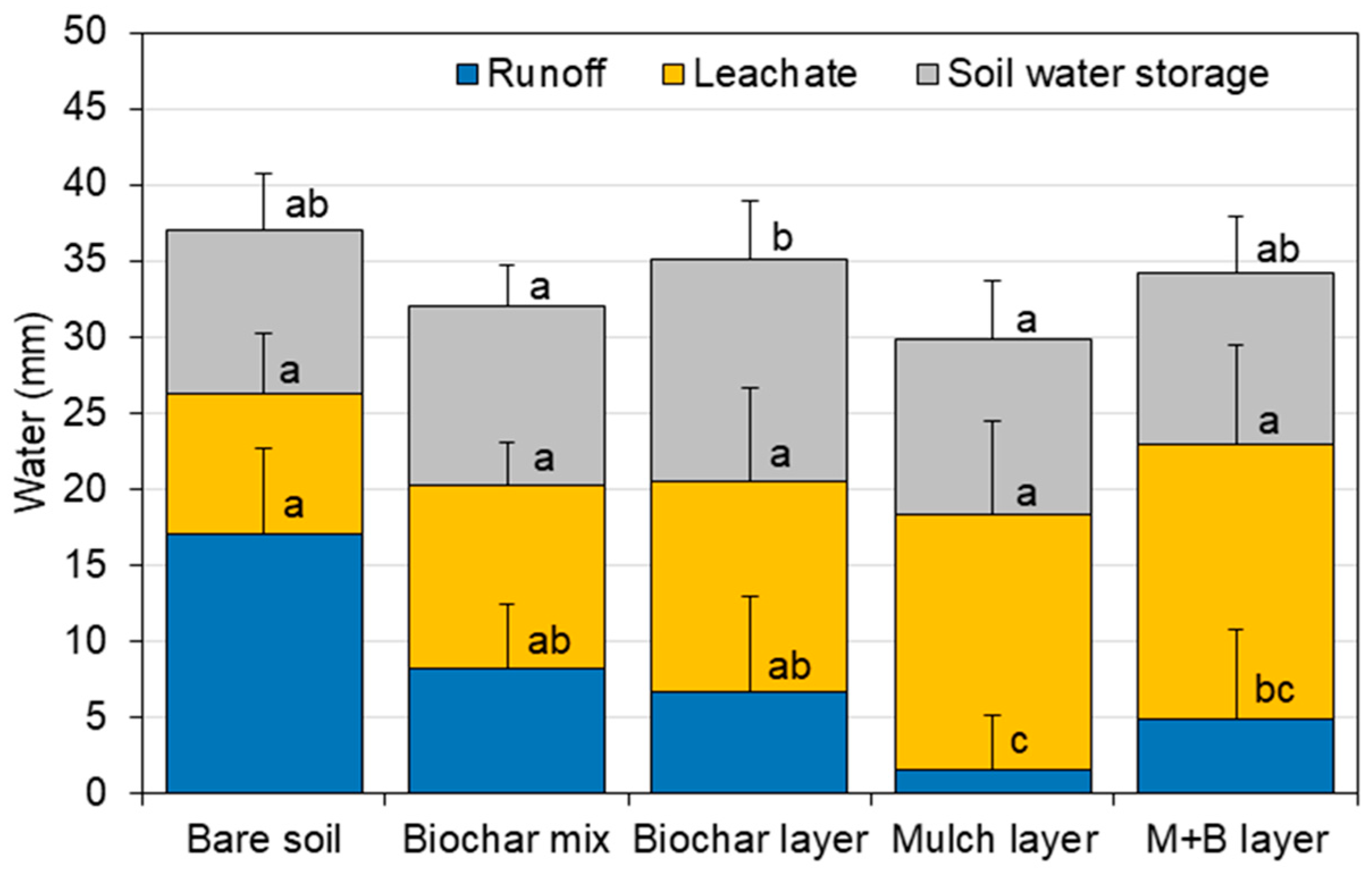
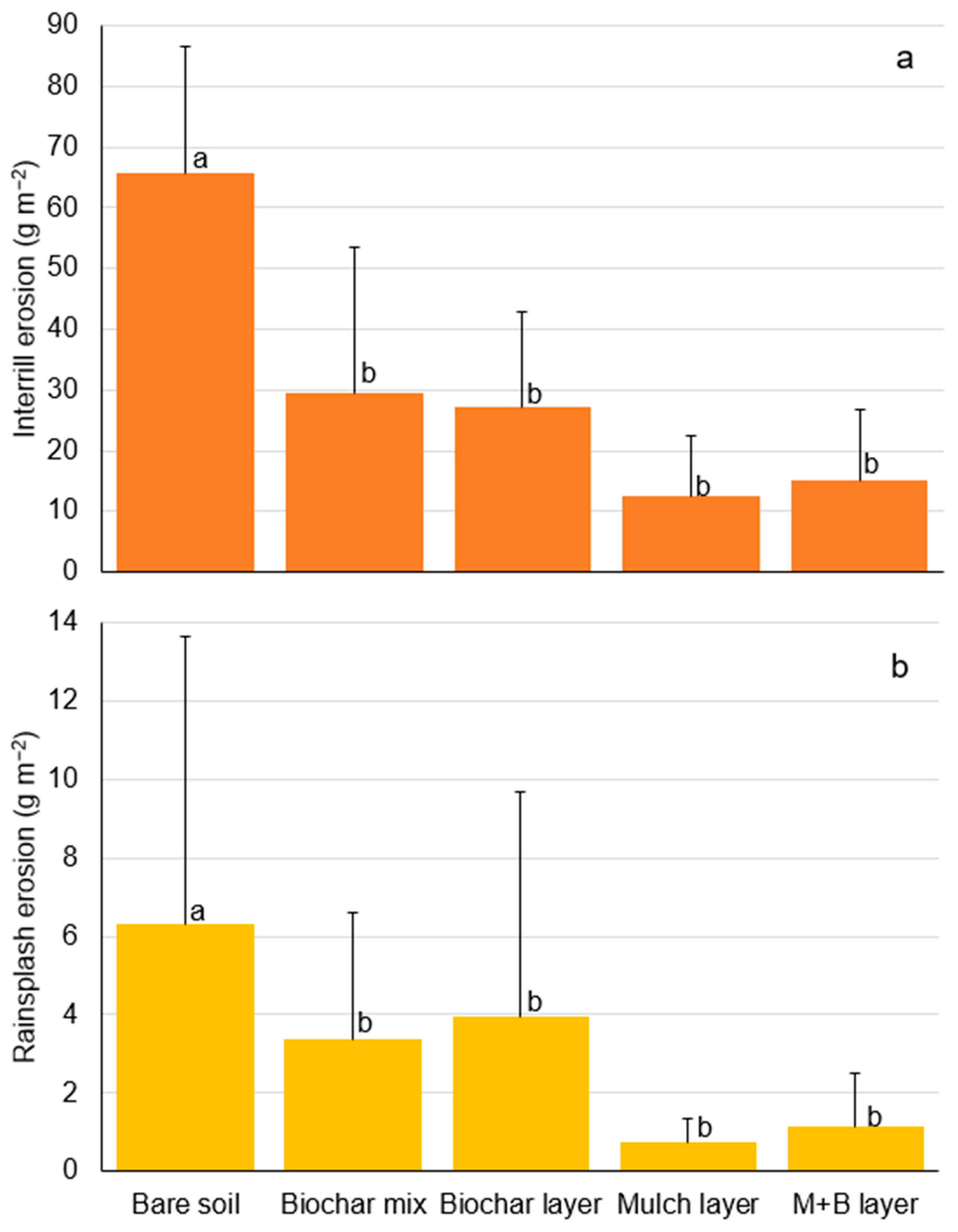
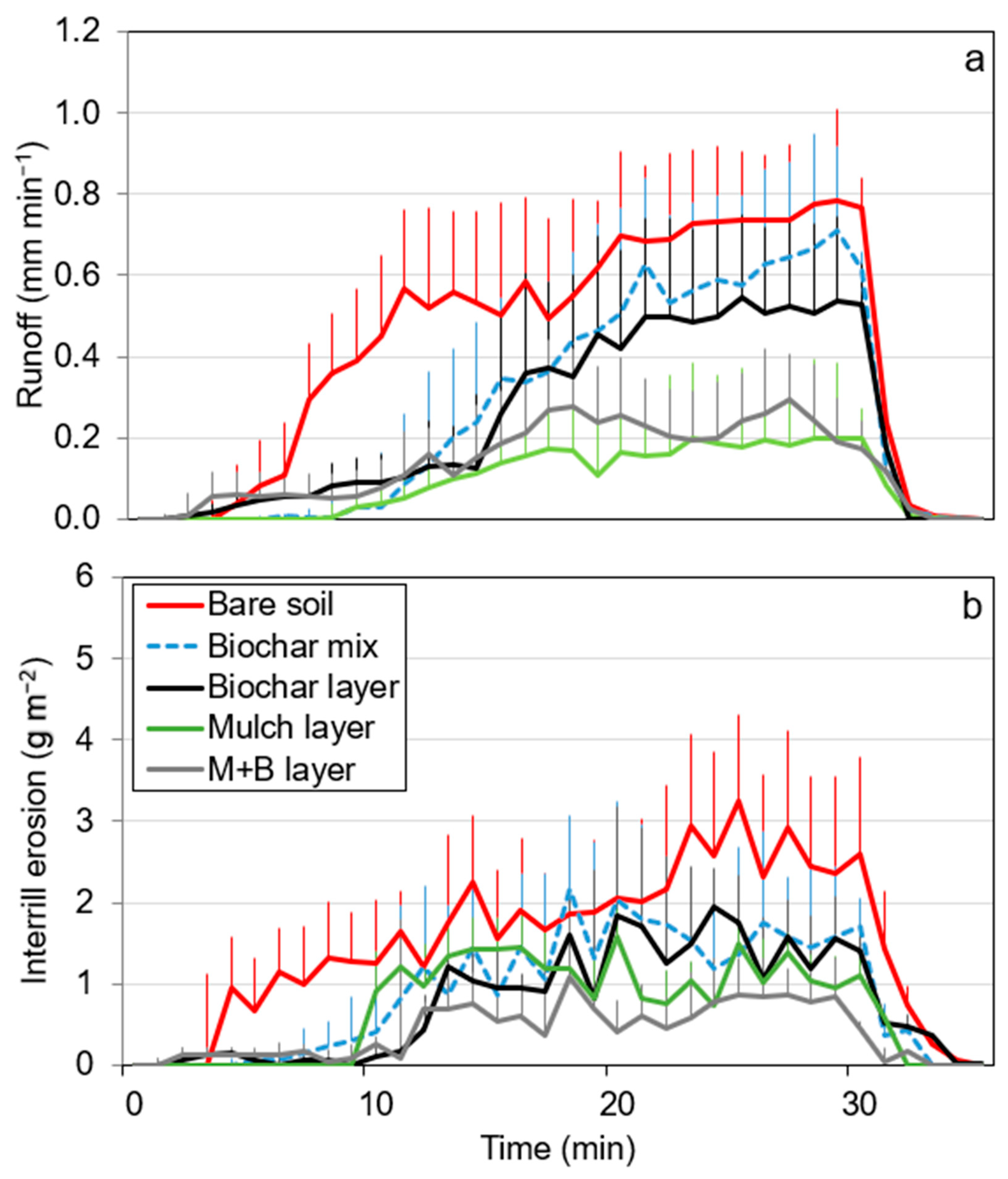
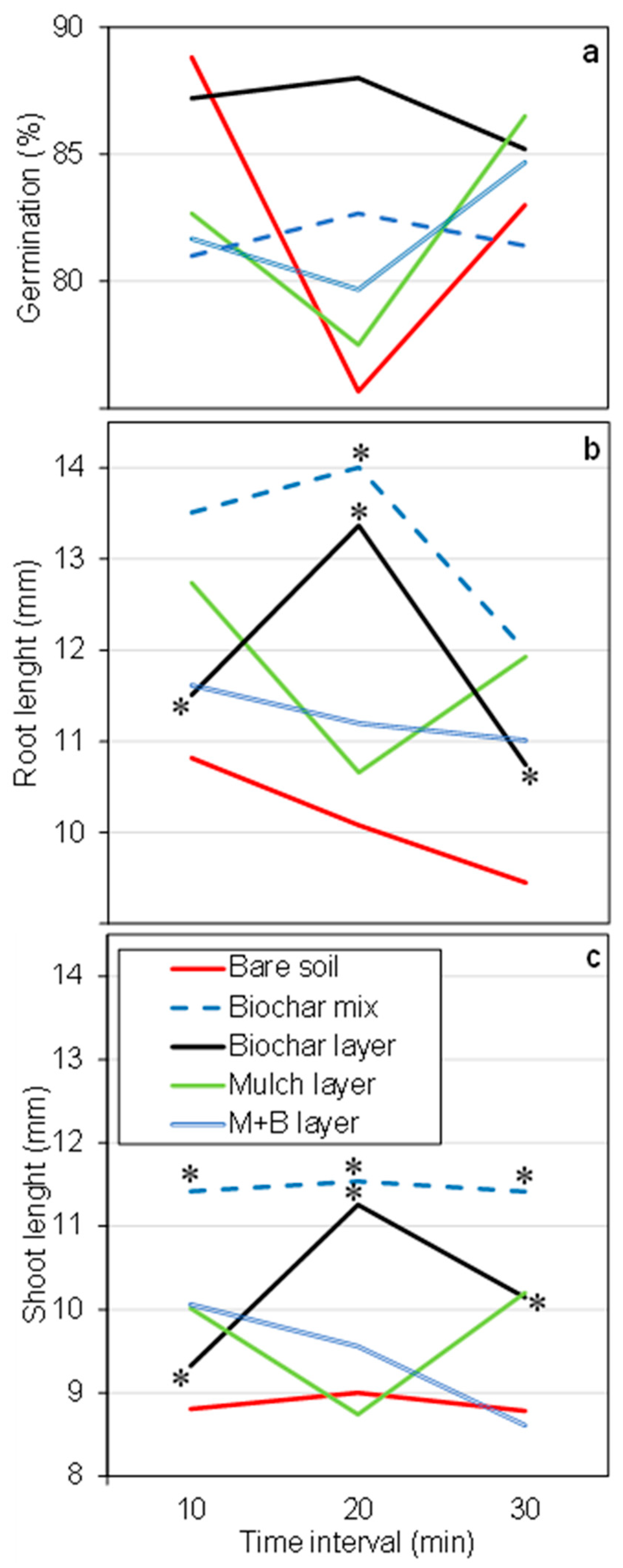
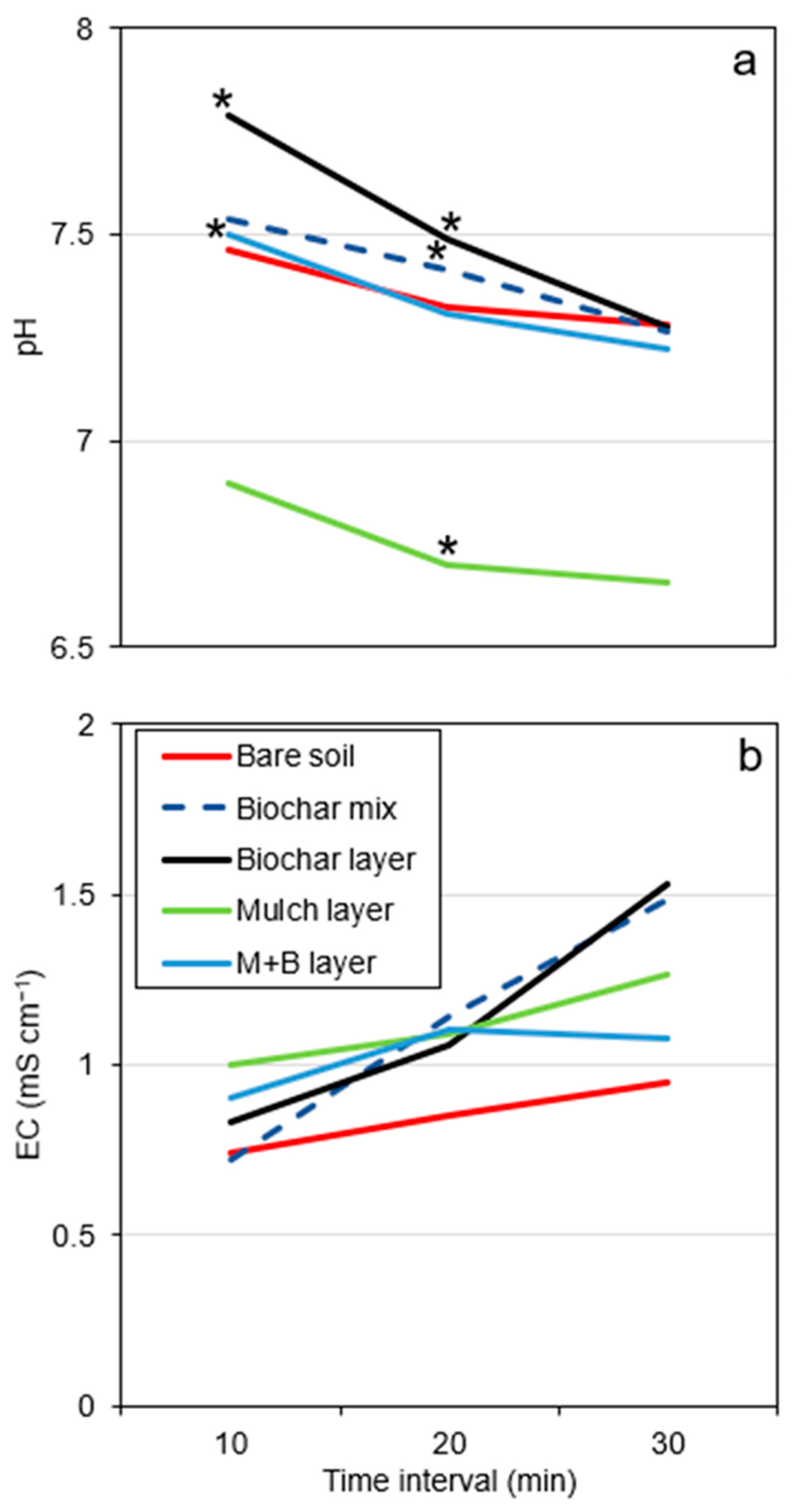

| Material | Application Rate (g m−2) | Cover Contribution (%) | Layer Thickness (mm) | Organic Matter Content (%) | Water Holding Capacity (mL) | Bulk Density (g cm−3) | pH | Electrical Conductivity (mS cm−1) | PAHs Content (mg kg−1) | Repellency WDPT (s) |
|---|---|---|---|---|---|---|---|---|---|---|
| Biochar | 1000 (0) | 100 (0) | 5 (2) | 93.8 (5) | 50 (0) | 0.6 (0.1) | 9 (0.3) | 0.5 (0.1) | 14.9 | 3 (2) |
| Straw | 200 (0) | 100 (0) | 40 (10) | 92.5 (5) | 50 (0) | 0.3 (0.1) | 5.5 (0.2) | 0.3 (0) | <0.04 | 6 (4) |
| Soil A | - | 0 (0) | 40 (0) | 5 (0.8) | 48.3 (0.5) | 1.30 (0.12) | 6.5 (0.2) | 0.06 (0) | <0.04 | 0 (0) |
| Soil B | - | 0 (0) | 40 (0) | 4 (0.6) | 44.1 (0.6) | 1.34 (0.15) | 5.7 (0.2) | 0.08 (0) | <0.04 | 0 (0) |
| Soil–biochar mix A | 1000 (0) | 0 (0) | 40 (0) | 7.5 (1) | 48.5 (0.4) | 1.22 (0.09) | 7.1 (0.2) | 0.07 (0) | 0.46 | 0 (0) |
| Soil–biochar mix B | 1000 (0) | 0 (0) | 40 (0) | 6.5 (1) | 44.4 (0.3) | 1.26 (0.11) | 6.4 (0.2) | 0.09 (0) | 0.46 | 0 (0) |
| Homogeneous Mixture (Soil-Mixed) | Heterogeneous Mixture (Surface-Layered) | |||||||||
|---|---|---|---|---|---|---|---|---|---|---|
| Bare Soil | Biochar Mix | Biochar Layer | Mulch Layer | Mulch + Biochar Layer | ||||||
| Soil A | Soil B | Soil A | Soil B | Soil A | Soil B | Soil A | Soil B | Soil A | Soil B | |
| Hydrological variables | ||||||||||
| Rainfall (mm) | 41 ± 1 a | 42 ± 1 a | 43 ± 3 a | 43 ± 3 a | 41 ± 1 a | 41 ± 1 a | 43 ± 3 a | 43 ± 3 a | 42 ± 1 a | 43 ± 3 a |
| Runoff (mm) | 15 ± 6 ab | 19 ± 4 ab | 8 ± 5 ab | 8 ± 4 ab | 6 ± 9 ab | 7 ± 4 b | 2 ± 4 a | 2 ± 4 a | 4 ± 7 ab | 5 ± 5 ab |
| Runoff coefficient (%) | 37 ± 15 ab | 45 ± 9 ab | 18 ± 11 ab | 18 ± 8 ab | 14 ± 17 ab | 17 ± 9 b | 5 ± 9 a | 5 ± 8 a | 10 ± 17 ab | 12 ± 11 ab |
| Soil water storage (mm) | 11 ± 4 abc | 10 ± 4 abc | 12 ± 1 abc | 11 ± 4 abc | 13 ± 1 a | 17 ± 4 b | 9 ± 3 c | 14 ± 1 ab | 8 ± 3 c | 14 ± 1 ab |
| Leachate (mm) | 11 ± 3 abc | 8 ± 4 abc | 11 ± 3 abc | 13 ± 2 abc | 15 ± 7 abc | 13 ± 5 ac | 21 ± 6 ab | 13 ± 3 c | 23 ± 8 b | 15 ± 2 abc |
| R. start (min) | 9 ± 4 ab | 8 ± 4 ab | 9 ± 4 ab | 13 ± 9 ab | 9 ± 7 a | 17 ± 6 ab | 22 ± 13 b | 19 ± 14 ab | 18 ± 13 ab | 14 ± 6 ab |
| R. end (min) | 31 ± 4 ab | 32 ± 1 ab | 33 ± 1 ab | 32 ± 1 ab | 30 ± 4 a | 33 ± 1 b | 33 ± 2 ab | 32 ± 2 ab | 32 ± 2 ab | 32 ± 2 ab |
| L. start (min) | 5 ± 2 abc | 6 ± 5 abc | 5 ± 2 abc | 7 ± 2 abc | 4 ± 1 a | 9 ± 3 b | 6 ± 1 a | 12 ± 2 b | 4 ± 2 ac | 10 ± 3 b |
| Erosion variables | ||||||||||
| Interrill (g m−2) | 53 ± 16 abcb | 80 ± 17 ad | 36 ± 33 bc | 23 ± 10 bc | 35 ± 25 ab | 19 ± 13 abcd | 17 ± 10 abcd | 8 ± 8 cd | 15 ± 11 abcd | 14 ± 14 abcd |
| Rainsplash (g m−2) | 6.2 ± 8 abcd | 6.4 ± 8 ad | 6.2 ± 2 abcd | 3.3 ± 5 bc | 3.1 ± 5 ab | 4.7 ± 7 abcd | 1 ± 1 abcd | 0.5 ± 1 cd | 0.8 ± 1 abcd | 0.5 ± 1 bc |
| Hydrologic | Erosion | Phytotoxic | |||||||||
|---|---|---|---|---|---|---|---|---|---|---|---|
| Runoff (mm) | Leachate (mm) | SWS (mm) | Interrill (g m−2) | Root Length (mm) | |||||||
| df | F Value | p Value | F Value | p Value | F Value | p Value | F Value | p Value | F Value | p Value | |
| Best fitting model | |||||||||||
| Treatment | 4 | 17.6 | <0.001 | 11.3 | <0.001 | 5.2 | <0.001 | 18.1 | <0.001 | 15 | <0.001 |
| Soil | 1 | 2.2 | 0.3 | 13.3 | <0.001 | 22.8 | <0.001 | 3.4 | 0.16 | 174 | <0.001 |
| Treatment * Soil | 4 | 0.2 | 0.85 | 3.5 | <0.05 | 7.7 | <0.001 | 2.3 | <0.05 | 22.8 | <0.001 |
| Individual models | |||||||||||
| Treatment | 4 | 18.1 | <0.001 | 9 | <0.001 | 3.3 | 0.14 | 16.5 | <0.001 | 13.9 | <0.001 |
| Soil | 1 | 0.9 | 0.54 | 8.4 | <0.05 | 15.3 | <0.001 | 2.2 | 0.25 | 154.5 | <0.001 |
| Layer | 1 | 16 | <0.001 | 12 | <0.001 | 1.7 | 0.19 | 18.5 | <0.001 | 5 | <0.05 |
| Biochar presence | 1 | 0 | 0.19 | 1.9 | 0.18 | 2.6 | 0.11 | 2.3 | 0.06 | 21.2 | <0.001 |
| Mulch presence | 1 | 37.8 | <0.001 | 26.4 | <0.001 | 2.1 | 0.16 | 29.5 | <0.001 | 0.7 | 0.4 |
| Homogeneous Mixture (Soil-Mixed) | Heterogeneous Mixture (Surface-Layered) | |||||||||
|---|---|---|---|---|---|---|---|---|---|---|
| Untreated | Biochar Mix | Biochar Layer | Mulch Layer | Mulch + Biochar Layer | ||||||
| Soil A | Soil B | Soil A | Soil B | Soil A | Soil B | Soil A | Soil B | Soil A | Soil B | |
| Phytotoxicity variables | ||||||||||
| Germination (%) | 85 ± 15 a | 79 ± 20 a | 88 ± 9 a | 79 ± 15 a | 88 ± 13 a | 83 ± 13 a | 82 ± 15 a | 82 ± 17 a | 83 ± 11 a | 81 ± 12 a |
| Root length (mm) | 12.3 ± 7 cf | 7.5 ± 4 g | 12.9 ± 6 bcd | 13.4 ± 7 e | 13.6 ± 7 a | 10.2 ± 6 df | 13.1 ± 6 abd | 5.5 ± 4 g | 11.1 ± 7 e | 11.4 ± 7 e |
| Shoot length (mm) | 9.8 ± 5 f | 7.7 ± 4 eg | 10.9 ± 5 cf | 11.8 ± 6 bg | 11.7 ± 5 a | 8.8 ± 5 ac | 10.3 ± 4 b | 6.6 ± 5 d | 8.2 ± 5 de | 10.6 ± 5 f |
| Leachate pH | 7.5 ± 0.1 ab | 7.2 ± 0.4 b | 7.3 ± 0.4 ab | 7.5 ± 0.2 a | 7.7 ± 0.5 ab | 7.2 ± 0.2 ab | 7 ± 0.2 ab | 6.4 ± 0.2 ab | 7.4 ± 0.5 ab | 7.3 ± 0.2 ab |
| Leachate EC | 0.7 ± 0.4 ab | 1.1 ± 0.6 b | 1.3 ± 0.7 ab | 0.9 ± 0.4 a | 1.2 ± 0.7 ab | 1.1 ± 0.2 ab | 1.1 ± 0.7 ab | 1.2 ± 0.4 ab | 0.7 ± 0.2 ab | 1.2 ± 0.4 ab |
Disclaimer/Publisher’s Note: The statements, opinions and data contained in all publications are solely those of the individual author(s) and contributor(s) and not of MDPI and/or the editor(s). MDPI and/or the editor(s) disclaim responsibility for any injury to people or property resulting from any ideas, methods, instructions or products referred to in the content. |
© 2025 by the authors. Licensee MDPI, Basel, Switzerland. This article is an open access article distributed under the terms and conditions of the Creative Commons Attribution (CC BY) license (https://creativecommons.org/licenses/by/4.0/).
Share and Cite
Canedo, J.N.G.V.; Coelho, L.; Castro, L.; Verheijen, F.G.A.; Prats, S. Biochar and Mulch: Hydrologic, Erosive, and Phytotoxic Responses Across Different Application Strategies and Agricultural Soils. Agronomy 2025, 15, 926. https://doi.org/10.3390/agronomy15040926
Canedo JNGV, Coelho L, Castro L, Verheijen FGA, Prats S. Biochar and Mulch: Hydrologic, Erosive, and Phytotoxic Responses Across Different Application Strategies and Agricultural Soils. Agronomy. 2025; 15(4):926. https://doi.org/10.3390/agronomy15040926
Chicago/Turabian StyleCanedo, João N. G. V., Luísa Coelho, Livian Castro, Frank G. A. Verheijen, and Sergio Prats. 2025. "Biochar and Mulch: Hydrologic, Erosive, and Phytotoxic Responses Across Different Application Strategies and Agricultural Soils" Agronomy 15, no. 4: 926. https://doi.org/10.3390/agronomy15040926
APA StyleCanedo, J. N. G. V., Coelho, L., Castro, L., Verheijen, F. G. A., & Prats, S. (2025). Biochar and Mulch: Hydrologic, Erosive, and Phytotoxic Responses Across Different Application Strategies and Agricultural Soils. Agronomy, 15(4), 926. https://doi.org/10.3390/agronomy15040926






